Xiaomi Mi MIX: A Closer Look at the Design and Display
by Matt Humrick on April 10, 2017 7:00 AM EST- Posted in
- Smartphones
- Mobile
- Xiaomi
- Mi
- Snapdragon 821
Display Performance
The Mi MIX’s most prominent feature is its 6.4-inch IPS LCD display. In addition to its larger than average size, this display deviates from the usual 1920x1080 16:9 aspect ratio. Similar to what LG and Samsung have done with their G6 and S8 displays, Xiaomi has stretched the MIX’s display vertically, giving it a 17:9 aspect ratio and a 2040x1080 resolution with a sharp 360ppi pixel density. The extra 120 pixels added to the height are used for the onscreen controls, leaving a standard 16:9 window for content.
Xiaomi’s MIUI offers several different display options that affect white point, gamma, color gamut, and accuracy. For starters, there are three different color settings that are self explanatory: Standard (the default), Warm, and Cool. There are also three different options to control the display’s contrast. The default “Automatic contrast” mode claims to automatically “optimize contrast for available light.” The two other modes, “Increased contrast” and “Standard” (which leaves contrast constant), are not available when using the Warm and Cool color settings.
Chinese OEMs, including Xiaomi, have traditionally struggled with display calibration. Unbalanced RGB settings that result in poor grayscale performance and blue-tinted screens and wide-gamut panels or color compression that produce oversaturated colors are common issues. To see if the Mi MIX suffers from similar problems, we’ll use an X-Rite i1Pro 2 spectrophotometer for color measurements and an i1Display Pro colorimeter for luminance measurements, profiling it with SpectraCal's CalMAN software.
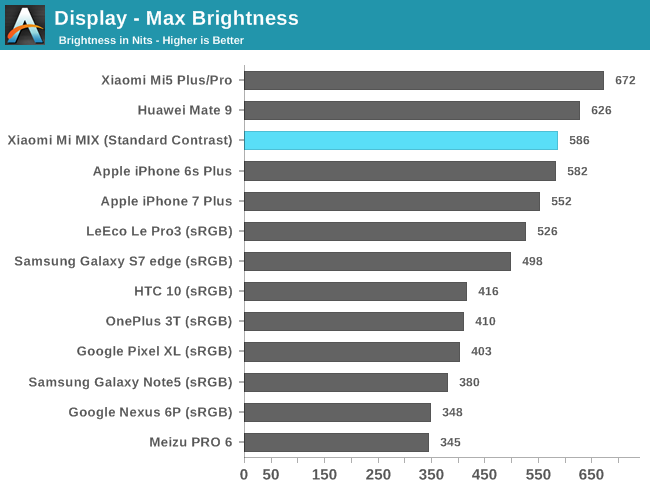
The Mi MIX gets plenty bright at 586 nits, falling just below the Mate 9 and the iPhone 7 Plus, which reaches up to 618 nits when using its auto-brightness boost (the value in the chart above is for manual mode). The MIX does not have a brightness overdrive feature when using auto-brightness, but its outdoor visibility is still very good. At its lowest setting, the MIX’s brightness drops to a mere 1 nit, which makes it usable even in a pitch-black room.
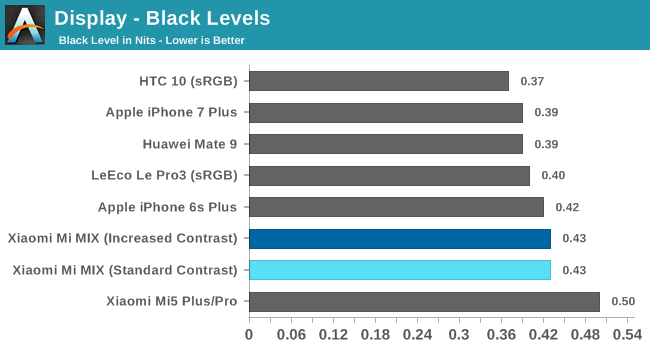

Black level and contrast ratio are measured at maximum brightness, which makes direct black level comparisons more difficult because a display’s black level increases with brightness; however, after normalizing for this effect, the Mi MIX still achieves a very good black level for an IPS display, falling just behind the Mate 9 and LG G5. Its black levels are on par with the iPhone 7 Plus and Xiaomi Mi5 and a little better than the HTC 10 at the same brightness level.
The phones with OLED panels are not shown in these charts because they are able to achieve a black level of zero and a mathematically infinite contrast ratio by being able to completely turn off individual pixels.
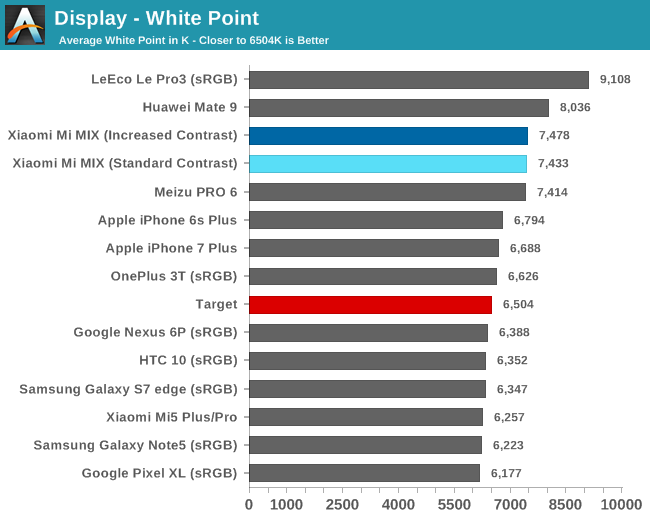

When using the Standard color setting, the MIX’s display takes on a slight blue tint. Its roughly 7,400K average white point is certainly cool, but not nearly as extreme as Huawei’s phones, including the Mate 9 and Honor 8, or other Chinese OEMs or even LG’s flagships. The Cool color setting is a bit more extreme, increasing the average white point to 8,249K by boosting the green and blue primaries at the expense of red. This gives the screen a very noticeable aqua-colored tint. The only other color mode, Warm, comes very close to hitting the D65 target white point by turning down the blue output, but there’s still an imbalance between the green and red primaries that gives the screen a bit of a green cast.
The Standard and Increased contrast modes have a well-calibrated gamma curve. Things get more interesting when using the Automatic contrast setting with the Standard, Cool, and Warm color modes (Automatic contrast is the only available option when using the Cool or Warm color modes). In an effort to improve screen viewability in different lighting conditions, the MIX dynamically adjusts the gamma curve, improving black levels or emphasizing highlights as necessary, which is not the same thing as Content Adaptive Backlight Control (CABC) that actually adjusts brightness by varying the backlight intensity.
You can see in the charts above how the MIX modified the gamma curve to improve the screen’s black level based on the ambient light during the test (a mixture of ambient daylight and incandescent bulbs). In direct sunlight, the gamma curve looks very different, with gamma dramatically reduced below 50% luminance to brighten darker areas of the screen, making more detail visible that would otherwise be overpowered by the ambient light. In such extreme conditions, being able to see what’s on the screen is far more important than accuracy, and this feature does help in these scenarios.
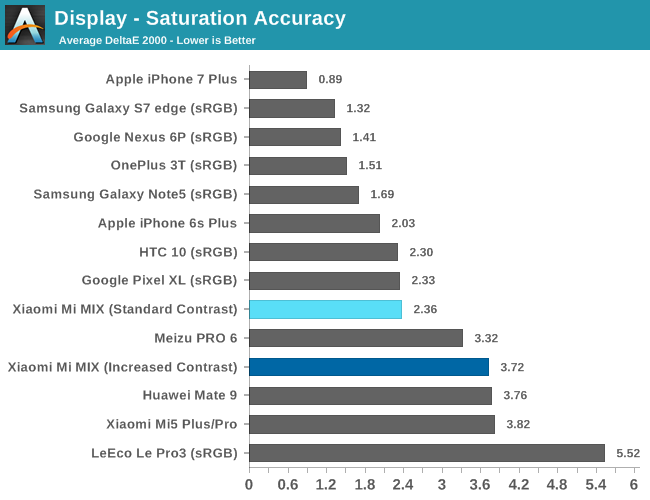
The MIX comes with a wide color gamut panel that covers the DCI-P3 color space, which extends coverage for the red and green primaries beyond sRGB (shown by the inner triangle in the graphs above). This leads to oversaturated colors—particularly blues, magentas, and reds—because of Android’s lack of color management. People who prefer more vivid colors will not be disappointed here. If you prefer a more accurate portrayal of color, you will not be disappointed either. The MIX’s Standard contrast mode is actually an sRGB mode in disguise. It comes up a little short for pure blue, and the cool white point shifts color hues slightly (particularly the magenta and cyan secondaries), but overall this mode keeps ΔE2000 saturation error below the acceptable threshold of 3 with the exception of cyan.
Both the Cool and Warm color modes target DCI-P3 too, but exhibit greater saturation error as a result of hue shifts caused by the RGB imbalances shown in the grayscale graphs above.
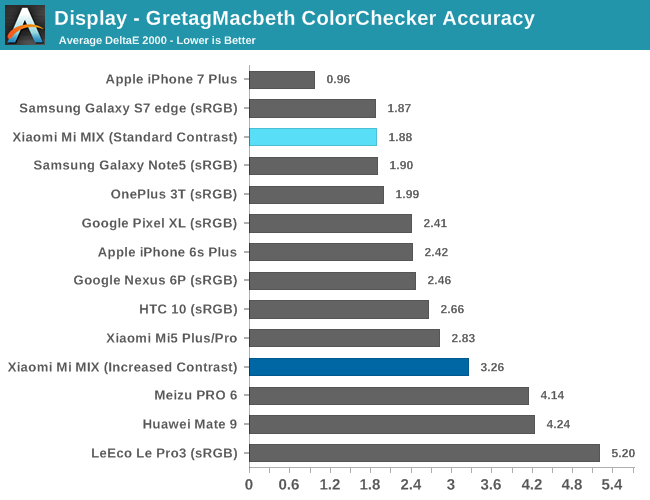
When using the Standard contrast (sRGB) mode, the Mi MIX displays colors very accurately, rivaling even Samsung’s current offerings. All of the tested colors have a ΔE2000 error below 3 (the yellow line above which error becomes noticeable to the untrained eye) and shades of green, yellow, and orange have an error below 1 (the green line below which error is basically imperceptible).
Using any of the other modes, which target a wider color space than sRGB, predictably results in greater error due to oversaturation. Note that the color error will vary slightly for the Cool and Warm color modes, along with the Standard mode with Automatic contrast, based on ambient lighting because of dynamic changes to the gamma curve. The results above should be pretty close, however, because most of the color error arises from oversaturation and hue shift caused by RGB imbalance.
The Mi MIX’s visual and functional appeal both hinge on the performance of its 6.4-inch edge-to-edge display. It’s a risky move, but fortunately it delivers. The high-quality panel has good viewing angles with no backlight bleed. There’s some IPS glow when viewing off center, but it’s not as bad as what we’ve seen from other displays we’ve tested recently. Xiaomi’s combination of color settings and display modes should satisfy most everyone; the wide-gamut modes deliver rich-looking colors while still keeping intermediate color blends looking fairly natural. It’s also great to see a reasonably well-calibrated sRGB mode for people who prefer greater accuracy.
This is a really great display overall. The only area where the MIX falls a little short is white balance, which is a little cool by default. It’s not nearly as bad as what we’ve seen on other Chinese phones, though, and it probably will not bother most people. Xiaomi provides the Cool and Warm color modes to shift the white point, but it would be nice to see finer grained controls.


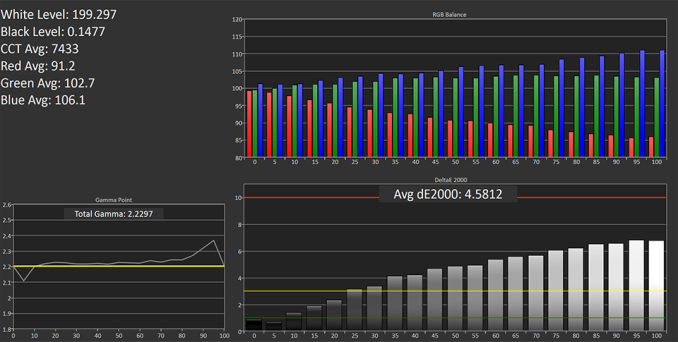

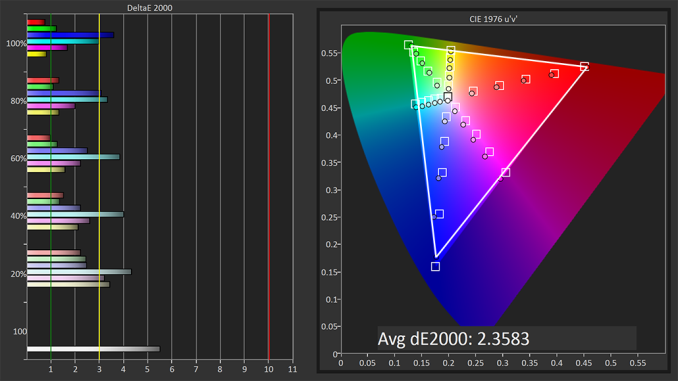
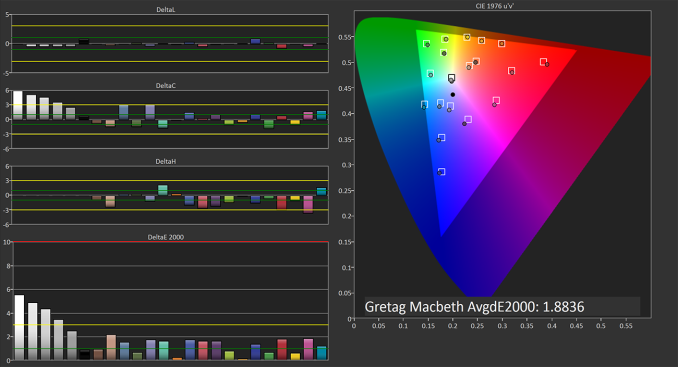









48 Comments
View All Comments
philehidiot - Monday, April 10, 2017 - link
Yeh this worries me a little. What eases my concern a little is that western "spy" agencies have access to most of our stuff anyway but you get the feeling that there is a little more professionalism and oversight going on there.... possibly...... a little.At the end of the day people quite happily throw a load of information at Facebook for "their friends" to see but not realising that if they're not paying for the product then basically they are the product. I wonder just how much my Amazon Dot is listening to me - there's an interesting criminal court case where what the Amazon box picked up will be used as evidence and I for one will be very interested to know why it recorded anything at all without the activation command being spoken and what it recorded. My Dot may be headed for the bin.
I think we have to accept that "software extras" are just the norm these days, whether they are corporations or our own governments who can just watch and listen to us as they please. Whether the Chinese or Russians are necessarily worse at this than us may just be a feature of our biases rather than based in fact but I don't think any of us actually have enough information in order to make that assessment.
If however you're on about organised crime sticking malware / spyware on there for the purposes of extracting credit card data, etc then I concur. There is evidence that large numbers of phones are being intercepted somewhere along the line and infected which is why my girlfriend's new phone got a full virus scan performed before she started putting any data on it whatsoever. Not fool proof but better than nothing. I think the risk of this kind of issue is probably higher when the phones spend more time in countries where bribing people to say, park a truck up for a few hours whilst they go for a nice break, is seen as the norm.
Drumsticks - Tuesday, April 11, 2017 - link
Per your echo comments... how do you suppose it hear an activation command without it recording your audio? It has to process the audio in order to determine if it matches the activation command, and to do that, it has to record.According to Amazon, that audio is stored locally on the device, but is not transmitted to Amazon servers. I'd probably trust them on it; there isn't really a way to do this without recording, and it'd be pretty easy to tell if there were an increased number of transmissions to amazon servers when you were speaking.
Daniel Egger - Tuesday, April 11, 2017 - link
No, that's not what they're saying. Amazon says they'll detect the keyword(s) locally before sending the recording over to their servers. Since there's no way of reliably figuring out whether that is true, how reliably the keyword detection works and how easy it is to work around this "protection" I'd rather stay the hell away from that crap.Daniel Egger - Monday, April 10, 2017 - link
Now Xiaomi, please the same in non-phablet size and I'd be all over it...uhuznaa - Monday, April 10, 2017 - link
Putting the front camera in the bottom right corner seems to be a high price to pay for having no bezel on top of the screen. Looks a bit gimmicky to me.SquarePeg - Monday, April 10, 2017 - link
Yes. That overly large single bottom bezel looks horrible. If they would just split it between the top and bottom of the phone for two very small bezels it would look much better.MrSpadge - Monday, April 10, 2017 - link
No: the bottom is often obstructed by the fingers in some way. And the bottom of the keyboard becomes really difficult to reach without a bezel. So giving the "full" bezel size to the nominal bottom is fine, because you have the orientation sensor if you turn the phone around to use the front camera (as Trixanity already said).zodiacfml - Monday, April 10, 2017 - link
Except that some users doesn't have a use for the selfie camera. You have a point though that they could get away without the Piezo electric speakers, increased drop durability, top front camera, probably lower cost, and improved landscape handling for games if there's a bezel at the top with a size similar to the S8.I don't appreciate the ceramic body. I see no value despite costing Xiaomi and consumers.
Trixanity - Monday, April 10, 2017 - link
You do know that you can just turn the phone upside down and take a selfie, right? You should be mad at Dell doing the same on a laptop where you can't do anything about it.vanilla_gorilla - Monday, April 10, 2017 - link
I don't know if I've ever taken a selfie and I don't do video conferencing from my phone. So for me, I couldn't care less. If there was no front facing camera at all I don't think I'd even notice.